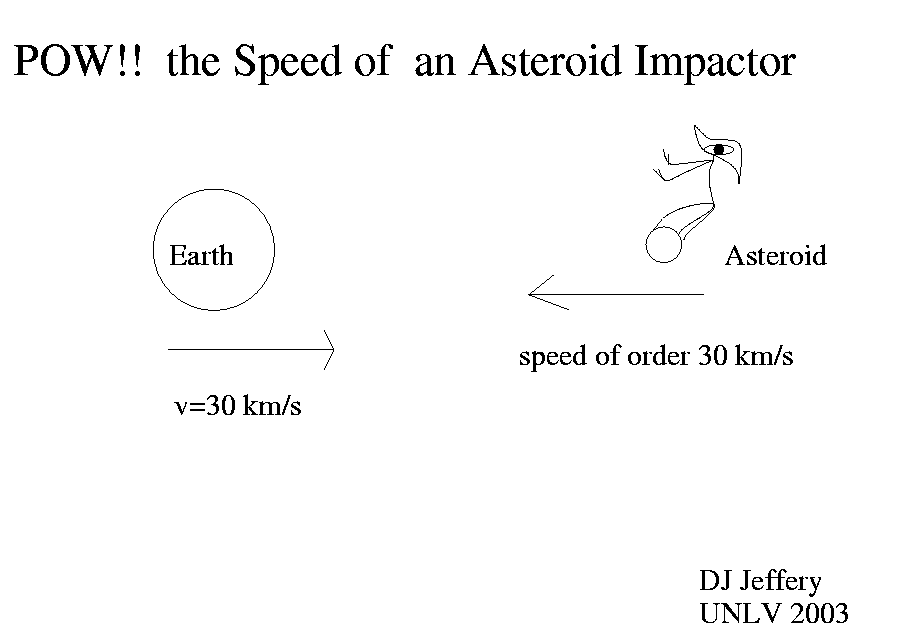
Caption: A head-on impactor asteroid aimed at Earth!!!
Features:
- Newtonian physics
dictates that any impactor
in orbit near the
Earth's orbit
must have a comparable
orbital velocity
to that of the
Earth's: both of which are
measured
relative to the
free-fall
inertial frame
of the Solar System barycenter
which is approximately
at the Sun with
orbital rotation measured relative to the
observable universe
(which is considered to be
absolute rotation).
- Since the
Earth's mean orbital speed = 29.78 km/s,
a head-on impactor
asteroid
would have
relative velocity
toward the
Earth
of ∼ 60
kilometers per second (km/s).
Pow!!!!
Most impactors probably hit with a lower relative velocity of order kilometers per second (km/s) or 10s of kilometers per second (km/s) since they should mostly hit us somewhere between from behind and the side. This is because almost all or all significant solar system bodies orbit the Sun counterclockise as view from way above the North Pole.
So head-on collisions are a bit unlikely.
However, a long-period comet might be a head-on impactor. Long-period comets come from the Oort Cloud: a vast spherical shell of rocky-icy bodies in orbit around the Sun. Oort Cloud objects (OCOs) can have any orbital orientation and direction relative to the ecliptic plane: i.e., the plane of the Earth's orbit.
- However even at
kilometers per second (km/s)
or 10s of
kilometers per second (km/s)
an the impact will be devastating for any
impactor
asteroid or
comet
of order
1 km in diameter or larger.
All the impactor's
kinetic energy
gets rapidly converted to
heat energy
via a deep impact
and the heat energy
explosively vaporizes surrounding
rock
creating a massive
explosion.
- The following
fiducial-value formula gives
the TNT equivalent
for impact events:
E_TNT = (625.7 ... Megatons TNT)*(density/1 gm/cm**3) *[(diameter/1 km)**3]*(velocity/1 km/s)**2 ,where we use for fiducial values for density the fiducial value water density = 1 gm/cm**2, for diameter 1 km, and for relative velocity 1 kilometer per second (km/s).For comparison, the most powerful hydrogen bomb the Tsar Bomb yielded 50 Megatons TNT.
- Cretaceous-Paleogene (K-Pg) extinction event
(a mass extinction)
of 66 Myr Before Present (BP)
(which extincted
the dinosaurs,
except for the birds)
is believed to have been caused by an
impactor
asteroid or
comet of
order 10 km in
diameter
(which cubed
gives a factor of 10**3 increase
over the fiducial yield)
with
a relative velocity
of order 10 km/s
(which squared
gives a factor of 10**2 increase
over the fiducial yield):
there is, in fact,
a net factor of 10**5 increase
over the fiducial yield.
- To be concrete, for the estimated values,
the fiducial-value formula gives
a yield of order
10**8 Megatons TNT.
Better estimates also give ∼ 10**8
Megatons TNT
(see
Wikipedia: Cretaceous-Paleogene (K-Pg) extinction event: Effects of impact).
- The impactor
probably caused vast plumes of hot solid and molten
rock
to be thrown up and fall back all around the
Earth causing
global or at least continental
firestorms.
Then there was probably
a multi-year global
impact winter
caused by aerosols lofted
into the Earth's atmosphere
and other bad things
(see
Wikipedia: Cretaceous-Paleogene (K-Pg) extinction event: Effects of impact).
But such large impactors
are relatively rare and we only have to worry a little about them relative
to other things: e.g.,
pandemics,
climate change,
nuclear war,
etc.
Local file: local link: earth_impactor_velocity.html.
File: Solar System file: earth_impactor_velocity.html.